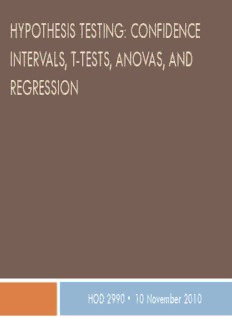
confidence intervals, t-tests, anovas, and regression - Vanderbilt PDF
Preview confidence intervals, t-tests, anovas, and regression - Vanderbilt
HYPOTHESIS TESTING: CONFIDENCE INTERVALS, T-TESTS, ANOVAS, AND REGRESSION HOD 2990 • 10 November 2010 Lecture Background This is a lightning speed summary of introductory statistical methods for senior undergraduate students in the honors program. They had designed their own research studies and had collected quantitative data. The previous lecture had covered data entry, data cleaning, and univariate and bivariate analyses. The lecture was occurring in a computer lab. The class had access to a common dataset collected from undergraduate students. After I introduced each new analytic method, we took time to do the procedure and explore the output thoroughly. Lecture time is four hours. Students were not expected to be experts on statistical analysis themselves. Rather, they should have been able to know possible avenues of analysis and begin to analyze their data with significant support Inferential Statistics The only way to know the true mean (or any other parameter) of a population is by surveying the entire population When we take only a sample of the population, we are inferring or generalizing known characteristics of the sample to the population Unfortunately, there is always uncertainty about whether the characteristics of our sample reflect the characteristics of the population This is true even if we have a representative sample and followed the best sampling methods available Confidence Intervals Confidence Intervals The confidence interval is an expression of that uncertainty, expressing an area around the sample mean we think the population mean is likely to fall The larger our sample, the smaller the confidence interval The larger the sample, the more sure we are that the sample mean approximates the population mean Confidence Intervals There are different confidence intervals, depending on how sure we want to be that the population mean falls within the CI The more sure we want to be, the wider the range of the confidence interval CI = Ẋ ± z(σ/√n) 1-α/2 90% CI: Ẋ ± 1.645(σ/√n) 95% CI: Ẋ ± 1.960(σ/√n) 99% CI: Ẋ ± 2.576(σ/√n) Confidence Interval Interpretation: if we took the a sample from the population repeatedly, in [90, 95, 99, or whatever confidence level we specify] percent of the samples the true population parameter will fall within the range generated by the CI equation Or, we are X% sure that the population mean falls within the range of the CI CAUTION Before we go on to examine hypothesis testing, there are several operative assumptions: Your data is properly entered and cleaned You know the univariate and bivariate distributions of your data T-tests T-tests When we have a continuous variable and we want to know if its mean differs in value between two groups, we use a t-test It is extremely rare that the groups will have exactly the same mean, but the t-test compensates for the uncertainty involved in measuring a population using a sample—basically, it measures whether or not the group means are far enough apart that we can be confident that they come from different distributions Example: Do male and female undergraduate students at Vanderbilt have different scores on the Satisfaction with Life scale?
Description: